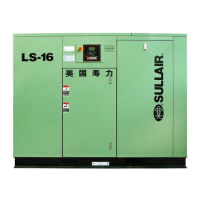Section 1
SAFETY
1
1.1 GENERAL
Sullair Corporation and its subsidiaries design and
manufacture all of their products so they can be op-
erated safely. However, the responsibility for safe
operation rests with those who use and maintain
these products. The following safety precautions
are offered as a guide which, if conscientiously fol-
lowed, will minimize the possibility of accidents
throughout the useful life of this equipment.
The compressor should be operated only by those
who have been trained and delegated to do so, and
who have read and understood this Operator’s
Manual. Failure to follow the instructions, proce-
dures and safety precautions in this manual can re-
sultinaccidentsandinjuries. Readthismanualprior
to startup.
NEVER start the compressor unless it is safe to do
so.
DONOT
attempt tooperatethecompressorwith
a known unsafe condition. Tag the compressor and
render it inoperative by disconnecting and locking
out all power at source or otherwise disabling its
primemover,sootherswhomay notknowofthe un-
safe condition, cannot attempt to operate it until the
condition is corrected.
Install, use and operate the compressor only in full
compliance with all pertinent regulations and all ap-
plicable Federal, State, and Local codes, standards
and regulations.
DO NOT
modify the compressor and/or controls in
any way except with written factory approval.
While not specifically applicable to all types of com-
pressors with alltypes of prime movers, most of the
precautionary statements contained herein are ap-
plicable to most compressors and the concepts be-
hindthesestatements aregenerallyapplicabletoall
compressors.
1.2 PERSONAL PROTECTIVE EQUIPMENT
Prior to installing or operatingthe compressor,own-
ers, employers and users should become familiar
with, andcomply with, allapplicable regulations and
any applicable Federal, State and Local codes,
standards, and regulations relative to personal pro-
tective equipment, such as eye and face protective
equipment, respiratory protective equipment,
equipment intended to protect the extremities, pro-
tective clothing, protective shields and barriers and
electrical protective equipment, as well as noise ex-
posure administrative and/or engineering controls
and/or personal hearing protective equipment.
1.3 PRESSURE RELEASE
A.Installanappropriateflow--limiting valvebetween
the service air outlet and the shut--off (throttle)
valve, either at the compressor orat any other point
along the air line, when an air hose exceeding 1/2”
(13mm) inside diameter is to be connected to the
shut--off (throttle) valve, to reduce pressure in case
of hose failure, per all applicable Federal, State and
Local codes, standards and regulations.
B. Whenthehoseisto beusedtosupply amanifold,
install an additional appropriate flow--limiting valve
between the manifold and each air hose exceeding
1/2” (13mm) inside diameter that is to beconnected
to the manifold to reduce pressure in case of hose
failure.
C. Provide an appropriate flow--limiting valve at the
beginningofeachadditional 75feet (23m)ofhosein
runsofairhoseexceeding1/2”(13mm) insidediam-
eter to reduce pressure in case of hose failure.
D. Flow--limiting valves are listed by pipe size and
rated CFM. Select appropriate valves accordingly,
inaccordance with their manufacturer’srecommen-
dations.
E. DO NOT use air tools that are rated below the
maximum rating of thecompressor. Select airtools,
airhoses, pipes,valves,filters, and other fittings ac-
cordingly. DO NOT exceed manufacturer’s rated
safe operating pressures for these items.
F. Secure allhoseconnections by wire,chainoroth-
ersuitableretaining devicesto preventtools orhose
ends from being accidentally disconnected and ex-
pelled.
G. Open fluid fillercaponlywhencompressor isnot
running and is not pressurized. Shut down the
compressor and bleed the sump (receiver) to zero
internal pressure before removing the cap.
H. Vent all internal pressure prior to opening any
line, fitting, hose, valve, drain plug, connection or
other component, such as filters and line oilers, and
before attempting to refill optional air line anti--icer
systems with antifreeze compound.
I. Keep personnel out of line with andaway from the
discharge opening of hoses or tools or other points
of compressed air discharge.
J.
Useairatpressureslessthan30 psig(2.1bar)for
cleaning purposes, and then only with effective chip
guarding and personal protective equipment.
K. DO NOT engage in horseplay with air hoses as
death or serious injury may result.
L. DO NOT tamper with sump andunit (ifprovided)
relief valves. Check the relief valve as recom-
mended in the Maintenance Section of this manual
or at a minimum of at least weekly to make sure it is
not blocked, clogged, obstructed or otherwise dis-
abled. DO NOT changethefactory settingofthere-
lief valve.
M.
If the compressor is installed in an enclosed
area, it is necessary to vent the relief valve to the
outside of the structure or to an area of non--expo-
sure.

